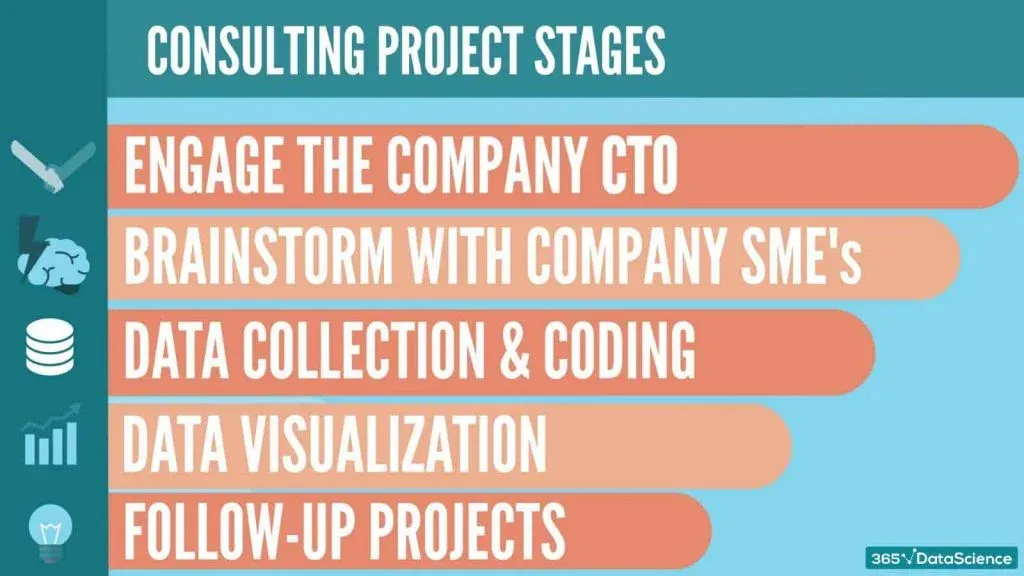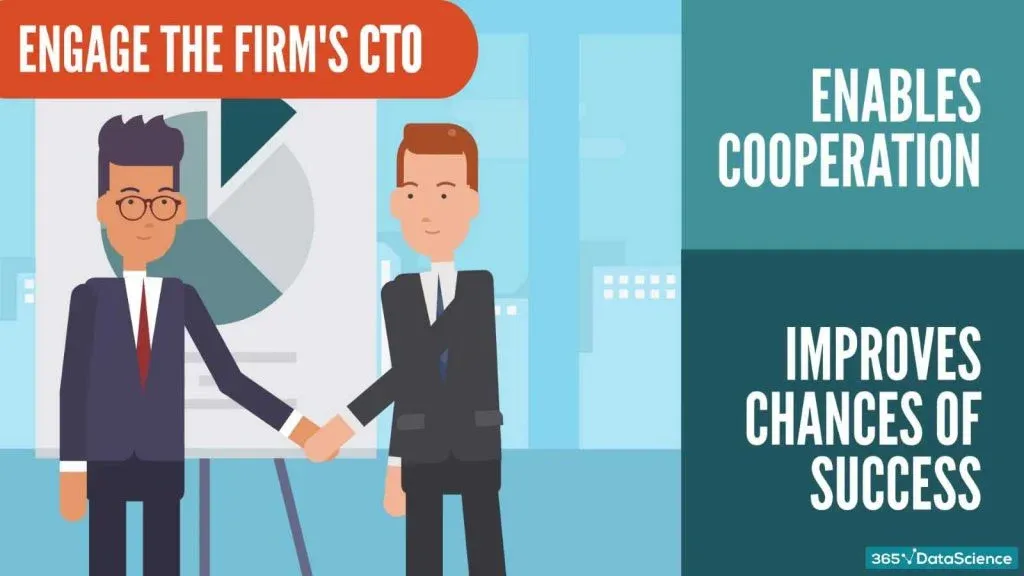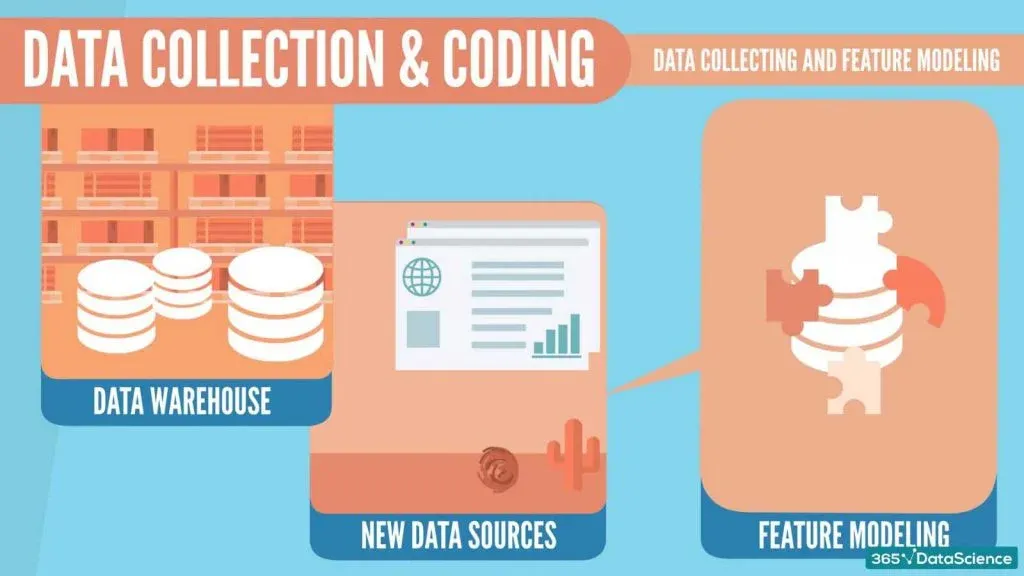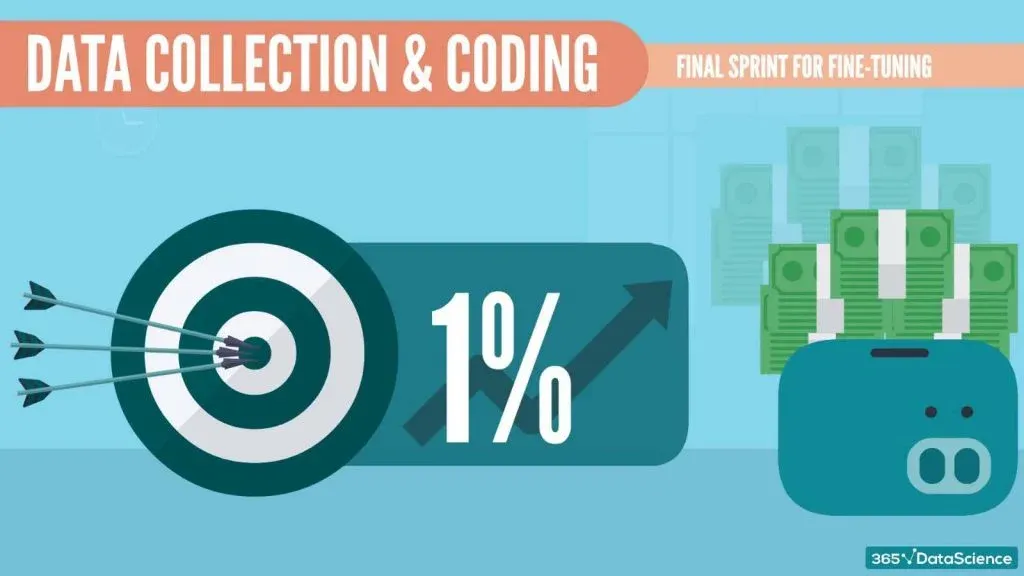
In this article, we'll focus on how IBM Consulting uses data science and analytics to deliver growth solutions to its corporate clients. From ideation to implementation, we’ll explore the meticulous process followed by the company’s data science team. This overview will help you decide if working for IBM or one of the other data science consulting companies hiring now is the right choice for you.
In addition, it will give you an insider’s look at how a consulting project that involves data analysis and data science typically unfolds.
To complement our overview, we’ll examine a set of business cases involving major clients that IBM has consulted. These include Nedbank, JP Morgan, and Experian who each benefited from data-driven solutions to their individual business challenges. While at the same time, serving as an example to the rest of the companies in their field.
Exploring these case studies will let us makes sense of the wider implications of the data science consulting process – it precipitates continued innovation. So, every time a company such as J. P. Morgan manages to leverage AI to improve its encryption protocols, the rest of the global banking leaders are basically obliged to follow suit. Thus, developing the technology even further.
Table of Contents
- Stages of an IBM Technology Consulting Project
- Why Do Global Businesses Trust IBM’s Consulting Services?
- Data Science Consulting: Beyond IBM
Stages of an IBM Technology Consulting Project

Let’s get right in and outline the five stages of a data science consulting project that IBM typically follows.
- Engage the firm’s CTO
- Meet with company SMEs and brainstorm
- Data collection and modeling through coding sprints
- Visualization and communication of findings
- Follow-up projects
Each of these steps is vital. So, let’s elaborate by describing them one by one in more detail.
I. Step One: Engage the Firm’s CTO
Things start with a conversation between the consulting team and the firm’s Chief Technology Officer.
They need to be sold on the project. Hopefully, this would result in them championing and endorsing the initiative across the organization. Such buy-in enables cooperation and improves the project’s chances of success.
At this stage, the consulting team and the CTO will define the scope of work and the ‘lowest hanging fruits'. The latter will give an immediate boost in terms of bottom-line results. But what do we mean by ‘lowest hanging fruit’? It is the easiest-to-implement opportunity that the data science team knows is available for most companies in an industry.
In many cases this is putting to work data that has already been accumulated by the company and improving data connectivity across the spectrum of business operations. In fact, according to a PwC and Iron Mountain report as much as 76% of companies are unable to extract value from their data, with 36% of those reporting this is due to a lack of data literacy and proper infrastructure.
So, an absolute best practice that IBM Consulting champions is to address such opportunities first. This gives instant credibility to the project team and wins support across the organization.

II. Step Two: Brainstorm with SMEs
Once the project scope has been identified with the firm’s CTO, the data science consulting team brainstorms on the final points of application with key players within the organization.
In other words, the team needs to conduct a series of interviews and meetings with Subject Matter Experts. These are the people who work in the business day in and day out and in many cases are responsible for master data governance. They are also the ones who can contribute greatly to identifying actionable and meaningful solutions. Also, in most cases, SMEs have a good idea of what data is available; and if it can be used for the purposes of the project at hand.

III. Step Three: Coding Sprints
a. First sprint: collecting data and feature modeling
Data collection sounds like ‘getting the data from all places’. However, it can be much trickier. Depending on the scope of the project, the consulting company may need to first consolidate all data in one place. This is what we call a data warehouse. In some cases, the amount of data is not enough. This means new data sources must be set up.
Feature modeling also comes up at this stage. The reason behind this is that features may be chosen from the available data. Sometimes, however, companies can miss very important metrics. IBM can then suggest collecting data on that. Thus, it changes the data collection structure of the client.

b. Second sprint: feature selection and running the model for the first time
Once data has been collected and features have been modeled, it is time for some real data science.
Specialists modeled and selected features during the first sprint. However, they never tested them inside a model. So, in the second coding sprint, the team
- evaluates,
- transforms,
- or engineers new features.
Only this time for predictive modeling purposes. Once ready, the first models come to life, and IBM Consulting proudly display their potential to stakeholders in the client company.

c. Third sprint: fine-tuning the model and adjusting it as per client requirements
The moment a solid model has been brought forward, the fine-tuning begins. There are many ways to improve a model. A 1% increase in accuracy could imply millions of dollars in savings for the client company. Therefore, this step should not be overlooked. Even if it sounds like the least exciting one.

IV. Step Four of IBM Watson Consulting: Data Visualization
Data visualization plays a critical role in most data science projects. However, the specialists who build a model are not always the ones best equipped to visualize its findings. When presenting in front of a non-technical business team, Tableau or Power BI graphs are preferable to a Jupyter notebook. So, the data science consulting team needs chart and dashboard creation skills... And the ability to communicate in an effective way. It is not uncommon for IBM Consulting teams to have a person whose job is to solely style the findings of their projects. In fact, this is the final touch to a successful implementation.

V. Step Five: Follow-up Projects.
The business-savvy data science team at IBM Consulting understand how decisions are made within companies. So, they make sure the insights they provide will accelerate the rate at which their clients embrace data-driven opportunities.
In other words, if the company sees a measurable bottom-line improvement, they'll want to retain the consulting team. And they'll be willing to purchase additional services. This is also why consulting firms prefer to start with low-hanging fruits. It allows them to show they can create value very fast. And hence they improve their chances of being hired again.

So, we’ve figured out the typical cycle of a data science consulting project. Let’s take a look at some of the successful use cases of the elite IBM’s consulting team. The work that IBM has done for these companies illustrates the power of data science to transform industries such as finance and information technologies.
Why Do Global Businesses Trust IBM’s Consulting Services?
1. Nedbank
Nedbank, a South African bank, implemented a model predicting ATMs’ need for repair. This led to important efficiencies in ATM reliability and maintenance timeliness.
2. JP Morgan
In another project, IBM’s data science team helped JP Morgan implement a powerful predictive model. The said model prevented the bank’s traders from engaging with inadvisable trades.
3. Experian
Experion is a leading company in the information business industry. They analyze credit payments on a global scale for a number of institutions. IBM’s team helped Experian leverage different types of data and create a more comprehensive view of Experian clients' businesses.
Data Science Consulting Beyond IBM
You could argue that data science and AI consulting is a business in its infancy. And that IBM’s consulting team has simply mastered the most important ingredient. Namely, the combination of technical know-how in terms of data science modeling and business understanding.
Truth is, a successful data science project needs both. And as more and more companies turn to analytics as a source of future growth, the potential applications of this science will continue to expand.
To help you find your footing in the data-driven transformation of global business, the 365 Data Science program puts heavy emphasis on the practical applications of data. From insightful use cases in every course, to a specialized business analytics career track, the 365 curriculum aims to provide you with the skills you need to turn raw information bites into commercial value.
Q&A
1. Is IBM Consulting Good?
Consistently ranked as one of the best consulting companies in the world, IBM provides expert services to a wide range of corporate clients. Even though the market for data science consulting has grown significantly, IBM are pioneers in the field and are still holding strong against the tides of competition. With a brand name as enormous as theirs, there is a lot at stake for IBM in the consulting world. Mostly known for their business software and cloud solutions, IBM’s services are instantly recognizable to professionals from almost any industry. They’ve been on the market for decades and they continue to innovate and expand their portfolio, now focusing on implementation-ready AI features that make using this technology as cost-effective and hassle-free as possible for their clients. Other consulting companies, including the Big 4 accounting firms, may have a larger overall share of the market, but IBM remains a household name in the analytics and data science consulting niche.
2. What Does a Consultant Do at IBM?
The role of a consultant at IBM can be incredibly diverse and fast-paced. Combining hard technical skills, analytic thinking, personability, and creativity, it has a lot of potential for an ambitious individual comfortable with a more public-facing position. As a consultant at IBM, your main goal is to sell the company’s services to business clients around the world. On the business side of things, this includes researching the operations of potential customers and identifying opportunities for data-driven improvement, maintaining a strong network of professional connections, presenting findings and reports. While from a data science perspective, you’ll be expected to select the optimal technological solution for your client’s needs, prepare and fine-tune models, lead coding sprints and implementation efforts, as well as visualize and present the results of your projects to laymen and specialists alike. In return for your hard work as a consultant at IBM, you can expect a salary in the range of $90,000 p.a., growth opportunities at one of the leading companies in the field, as well as an extensive package of benefits, including a top-tier learning and development program.
3. How Do I Get Selected for IBM?
The safest route to a position at IBM is through a degree in computer science complemented by a professional certificate from IBM themselves. Based on our research into the profiles of successful data science professionals, we’ve determined that the best overall degree for breaking into the field is computer science. On top of that, a certificate issued by IBM that demonstrates you have a deep understanding of the specific technologies used by IBM Cloud (Watson Studio) will make you stand out from the crowd. Alternatively, if you’re set on working at IBM Consulting, a degree in economics or another social science could also suffice. That’s because the analytic skills developed by such degrees are highly valued by companies for their potential for turning raw data into actionable insights. Of course, you would also have to demonstrate a high level of technical expertise. And the best way to do that is to hone your programming skills and invest in creating a solid portfolio of work.








